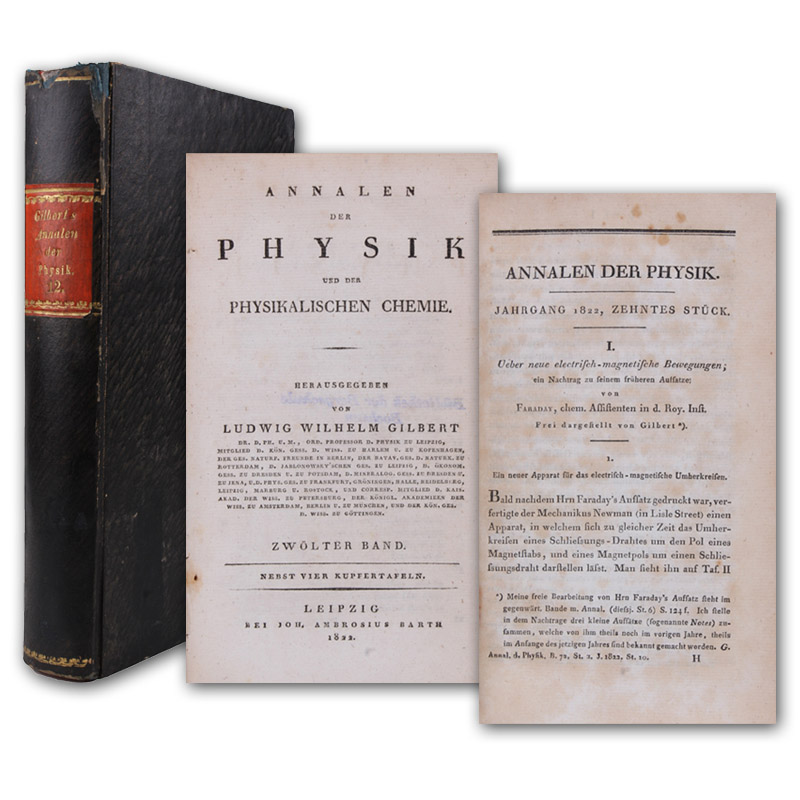112910-01
Ueber neue electrisch-magnetische Bewegungen, ein Nachtrag zu seinem früheren Aufsatze. Frei dargestellt von Gilbert. SS. 113-129. - Und: Ampere. Berichtigung seiner Theorie der electrisch-magnetischen Erscheinungen, und Vertheidigung derselben gegen mehrere ihr gemachten Einwendungen... Frei ausgezogen von Gilbert. SS. 136-157. - Und: Derselbe. Beschreibung der verbesserten Einrichtung des von ihm im Decemb. 1821 bekannt gemachten, und eines neuen electrisch-dynamischen Drehungs-Apparats, und Erörtung der Versuche, welche er mit beiden angestellt hat. Frei dargestellt von Gilbert. SS. 257-276. In: Annalen der Physik und der Physikalischen Chemie. Hrsg. L. W. Gilbert. Band 72.
Leipzig, Barth, 1822. - (20 x 12 cm). (12) 436 S. Mit 4 gefalteten gestochenen Tafeln und 4 gefalteten Tabellen. Pappband der Zeit.
Erste deutsche Ausgabe dieser bedeutenden Arbeiten über die elektromagnetische Rotation und den elektrischen Motor. - "Ever since Hans Christian Oersted's announcement of the discovery of electromagnetism in the summer of 1820, editors of scientific journals had been inundated with articles on the phenomenon. Theories to explain it had multiplied, and the net effect was confusion. Were all the effects reported real? Did the theories fit the facts? It was to answer these questions that Phillips turned to Faraday and asked him to review the experiments and theories of the past months and separate truth from fiction...Faraday agreed to undertake a short historical survey... His enthusiasm was aroused in September 1821, when he turned to the investigation of the peculiar nature of the magnetic force created by an electrical current. Oersted had spoken of the 'electrical conflict' surrounding the wire and had noted that 'his conflict performs circles'... Yet as he experimented he saw precisely what was happening. Using a small magnetic needle to map the pattern of magnetic force, he noted that one of the poles of the needle turned in a circle as it was carried around the wire. He immediately realized that a single magnetic pole would rotate unceasingly around a current-carrying wire so long as the current flowed. He then set about devising an instrument to illustrate this effect. His paper "On some new Electro-Magnetical Motion, and on the Theory of Magnetism" appeared in the 21 October 1821... It records the first conversion of electrical into mechanical energy. It also contained the first notion of the line of force" (DSB). - Titel und Tafeln verso gestempelt. Stellenweise etwas stockfleckig. Oberes Kapital etwas abgestoßen, sonst gut erhalten. - DSB 4, 527
Ueber neue electrisch-magnetische Bewegungen, ein Nachtrag zu seinem früheren Aufsatze. Frei dargestellt von Gilbert. SS. 113-129. - Und: Ampere. Berichtigung seiner Theorie der electrisch-magnetischen Erscheinungen, und Vertheidigung derselben gegen mehrere ihr gemachten Einwendungen... Frei ausgezogen von Gilbert. SS. 136-157. - Und: Derselbe. Beschreibung der verbesserten Einrichtung des von ihm im Decemb. 1821 bekannt gemachten, und eines neuen electrisch-dynamischen Drehungs-Apparats, und Erörtung der Versuche, welche er mit beiden angestellt hat. Frei dargestellt von Gilbert. SS. 257-276. In: Annalen der Physik und der Physikalischen Chemie. Hrsg. L. W. Gilbert. Band 72.
Leipzig, Barth, 1822. - (20 x 12 cm). (12) 436 S. Mit 4 gefalteten gestochenen Tafeln und 4 gefalteten Tabellen. Pappband der Zeit.
Erste deutsche Ausgabe dieser bedeutenden Arbeiten über die elektromagnetische Rotation und den elektrischen Motor. - "Ever since Hans Christian Oersted's announcement of the discovery of electromagnetism in the summer of 1820, editors of scientific journals had been inundated with articles on the phenomenon. Theories to explain it had multiplied, and the net effect was confusion. Were all the effects reported real? Did the theories fit the facts? It was to answer these questions that Phillips turned to Faraday and asked him to review the experiments and theories of the past months and separate truth from fiction...Faraday agreed to undertake a short historical survey... His enthusiasm was aroused in September 1821, when he turned to the investigation of the peculiar nature of the magnetic force created by an electrical current. Oersted had spoken of the 'electrical conflict' surrounding the wire and had noted that 'his conflict performs circles'... Yet as he experimented he saw precisely what was happening. Using a small magnetic needle to map the pattern of magnetic force, he noted that one of the poles of the needle turned in a circle as it was carried around the wire. He immediately realized that a single magnetic pole would rotate unceasingly around a current-carrying wire so long as the current flowed. He then set about devising an instrument to illustrate this effect. His paper "On some new Electro-Magnetical Motion, and on the Theory of Magnetism" appeared in the 21 October 1821... It records the first conversion of electrical into mechanical energy. It also contained the first notion of the line of force" (DSB). - Titel und Tafeln verso gestempelt. Stellenweise etwas stockfleckig. Oberes Kapital etwas abgestoßen, sonst gut erhalten. - DSB 4, 527
280 €

